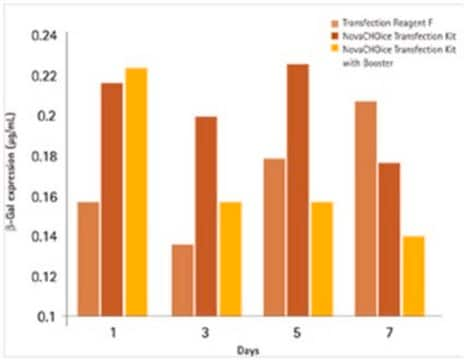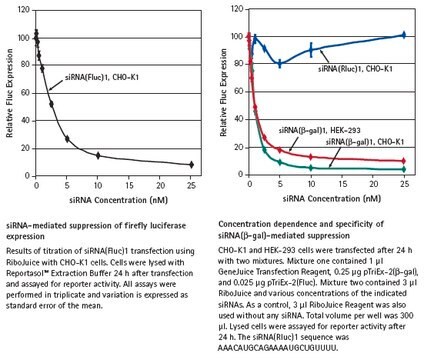L3287
Escort™ IV Transfection Reagent
Lipid reagent for transient and stable transfection of mammalian and insect cells.
Synonim(y):
Gene delivery
About This Item
Polecane produkty
klasa czystości
for molecular biology
Poziom jakości
Postać
liquid (aqueous solution)
zastosowanie
1 mL sufficient for 160-500 transfections
stężenie
1 mg/mL
metody
transfection: suitable
temp. przechowywania
2-8°C
Powiązane kategorie
Opis ogólny
Zastosowanie
Cechy i korzyści
- Suitable for stable and transient transfection
- Optimized for a wide variety of cell lines
- Low toxicity
- Compatible with both serum and serum-free transfection protocols
- Ideal for Sf9, Sf21 and S2 insect cells
Komponenty
1 mg/mL total lipid in water
Note the identity of the lipids used in Escort™ IV is confidential.
Przestroga
Zasada
Informacje prawne
produkt powiązany
Kod klasy składowania
10 - Combustible liquids
Klasa zagrożenia wodnego (WGK)
WGK 3
Temperatura zapłonu (°F)
Not applicable
Temperatura zapłonu (°C)
Not applicable
Środki ochrony indywidualnej
Eyeshields, Gloves
Certyfikaty analizy (CoA)
Poszukaj Certyfikaty analizy (CoA), wpisując numer partii/serii produktów. Numery serii i partii można znaleźć na etykiecie produktu po słowach „seria” lub „partia”.
Masz już ten produkt?
Dokumenty związane z niedawno zakupionymi produktami zostały zamieszczone w Bibliotece dokumentów.
Klienci oglądali również te produkty
Produkty
Transfection introduces genetic material into cells, aiding research in gene expression and cell biology.
Transfekcja wprowadza materiał genetyczny do komórek, wspomagając badania nad ekspresją genów i biologią komórek.
This brief webinar provides an overview of what transfection is and the methods that are used to introduce DNA or RNA into eukaryotic cells.
Protokoły
The product bulletin providin detailed use protocol for easy DNA transfection.
Biuletyn produktu zawiera szczegółowy protokół użytkowania ułatwiający transfekcję DNA.
Product manual provides detailed protocol for easy DNA transfection.
Universal Transfection Reagent enables efficient nucleic acid delivery into various cells, compatible with different cell culture conditions.
Powiązane treści
Browse our convenient transfection reagent selection guide to match the best reagent for your specific cell line and application needs.
Nasz zespół naukowców ma doświadczenie we wszystkich obszarach badań, w tym w naukach przyrodniczych, materiałoznawstwie, syntezie chemicznej, chromatografii, analityce i wielu innych dziedzinach.
Skontaktuj się z zespołem ds. pomocy technicznej











